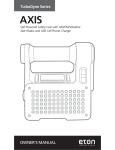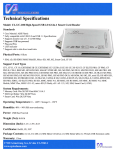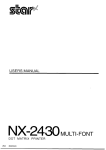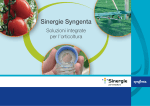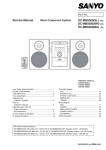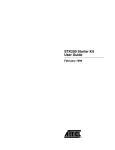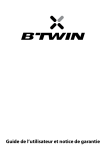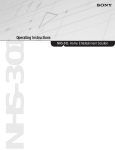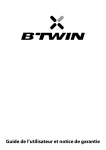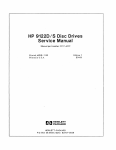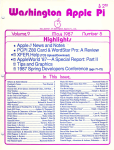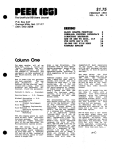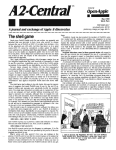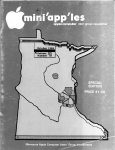Download Amazing Apple stories
Transcript
October 1988
VoL. 4. "". 9
ISSN 0885-40 17
newstand price: $2.50
photocopy charge per page: $0.15
Releasing the power to everyone•
.-.-.-.-.-.-.-.-.-.-.-.-.-.~.-.-.-.-.-.-.-.-.-.-.-.-~- ----
Amazing Apple stories
As happens all too often anymore. I once again find myself trapped
in Ihe infamous AppleFest time warp ...I'm writing this letter to you
before the new product introductions of AppleFest. butJou're reading
it afterward. I could ask you to pretend AppleFest l1asn'l happened
yet or I could report that Apple's supposed to h'ave a new IIc (the nc
flus) and the real froDOS 16 (GS/ OS) up its sleeves and hope it reaDy
does, Or I could just ignore the hubbub in San Francisco and tell you
some amazing Apple stories.
for example, have you heard thal Apple 0 software develop'
ers all received the 'Apple II System Disk, Version 3. 1. April 14, 1968'
the first week of September? Most of them threw it in the round file.
thinking Apple had really screwed up this time. since two months previously these same developers had received the 'Apple I1gs SyStem
Disk. Version 3.2. June 24, 1988' from Apple. Moreover, Ihey'li be get·
Ung Version 4.0 any day now.
'
But it wasn'l a total fiasco-it turns out many developers missed
the subtle difference that the disk Ihey got in July was a 'lIgs' disk,
while the September disk was a 'II' disk. Among olher goodies. the
September disk has the heretofore missing version 1,5 of ProDOS 8
(the July disk has version 1.6) ·and a new program selector called
LAUNCHER. SYSTEM that has a familiar interface but that allows you to
select only among System Utilities, FastCopy, Applesoft, or the
ancient froDOS throw,your-hands-up-and-quit routine. Otherwise.
everything on it duplicates material on the July IIgs disk. which is now
available for downloading on the major oriline services. Your d ealer
may even have a copy you can copy. If you don't have it yet, however.
walt for 4.0.
Bob Sander,Cederlof has ceased publication of hi. newsletter.
Apple AMembly Line. and gone to work for Applied Engineering. He
had previously done a number of projects for AE on a consuning
basis. This is the' second Apple II publication to ' pass away this
year-the other was Apple User, a British publication.
Sander-Cederlors last article was a" analysis of Apple's new
Basic.system. Version 1,2, It vividly demonstrates why his publication
will be missed:
whose change has any Significance. They have not fIXed even ONE of
the many published problems in Basic.system!
So what did they fix ? The description sheet that came with the
update said they were lIying to fIX a bug In the CATALOO command.
A variable they call TOTfNT, which happens to be at $BCB9-BCBA, is
used for a counter to control the loop that disptays file names and
info, When the directory is fi"t opened, the toml number of files in
the directory is,c ople(! into TOTfNT, The original intention of the pre:
grammer was to decrement TOTfNT aller reading each file enlly In
the directory. When the counter reaches zelO the catalog should be
l
finished, Unfortunately, the program did not decrement the counter
proper/yo
.
To malte maltets worse, the new code in version 1.2 does not fIX
the bug, Instead, the patch just omits testing TOTfNT altogether.
Now If you have a long directory, delete most the files leaving just a
few file names in the first few entries, and CATALOG it in Basicsystem, it will read all the entries anyway. No real problem, the disk just
spins a fraction ofa second longer,
The original bug was not a very serious problem either. It only
failed when the total number of active files in a direc/ory was a multiple of 256, which seldom happens. In fact it seldom happens that
there are that.many files in anyone directory, because so many of
the ulilities and even AppleWorl<s get confused with large directories.
The symptom you would see if you had exactly 256 files in a direct<>ry, as I understand it. is that you would get an 'OllT Of DATA' error
message at the end of the catalog instead of the 'n.umber of bloel<s'
line. I suppose thal could be unnerving, SO the bug should be
removed if possible.
The faulty decrement code is at the end of the Read Next catalog
fnlly subroutine, at $82 15, and Iool<s like this:
1l15: DEC $BCB9
1l18: BIll $B21D
ilIA: DIl: $5:BA
New Version 1.2 of BASIC,SYSTEM, by Bob Sander-Cedenof
(Copyright 1988 by S·C Software, reprinted with pennission)
When I receive a new version of something from Apple, my first
impulse is to try to find out exactly what they changed, fspecially,
when for tbe first time in four yeats, they update a program :So important as Basicsystem. And especially when there have been excellent
articles published in the last four years clearly describing definite
bugs, patches. and work,arounds,
.
.
I was very disappointed this morning after car<;fully analyzing the
new version 1.2 of Basicsystem, I started by J3LOAOing lhe old version 1.1 and they copying it into bank 2 of niy IIgs, Then I 8LOADed
the new version 1,2 and used the Monitor's V-command to compare
tbe two. There were a total of 24 bytes changed, T/1irteen were inside
the parameter block for a OetJile_Info call. so their value is irrelevant. One is a byte that is never referenced in any way. Three bytes
were changed in the title screen. sp that you see ' 1.2' instead of
' /' f'. and 'COPYR/GHT APPLE 1985,87' instead of COPYRIGHT
APPLE, 1983-84', That leaves only seven bytes in the total update
SORE,
MiLLION ·
5:EMS WKE IJJJf Rti/r /IrJN, aIr
WIJAT MCtJT RND{? WJlAT Aa:XJT HIS RJI1IP£? -mINK IlOO' A
CCMRJIER UfIE lIl5 WU 00 lOR HIS flU ~ ~"
4,66
Open-Apple
B21D: RTS
If the initial number in BCB9 (low byte) and Bc/lA (high 'byte) is
not a multiple of 256, this code will always result In BCBA going negative when the total value has been counted down. But if the -initial
value IS a multiple of 256, it will take an extra 256 times to count it
down to a negative value in BCBA. The end-of-Ioop test code is at
$B09f:
BOil: LOA $BCiA
BO'l: BPL $Bm
The correct way to decrement the 16-bit value is like this:
LOA $BCSI
BIlE .1
DEC $BCBA
.1
DRC $BCEI
This results in both bytes being zero when it is counted alllhe way
down. Code to test the TOTfNT variable for zero already exists at the
top of the loop in Basic.sy.stem.
BOlO: LO' $BCBI
BOll: ORA $BCBA
B016: BlQ $BOA3
A little restructuring of the code would result in even fewer bytes
being required to do the decrement and loop control correctly.
Instead. we have this strange wipe-out instead. Apple went furih er.
and changed the branch at $B076 to two NOPs, and the error branch
following the call to Read Next Catalog fntry to temlinate the catalog
without error. Very interesting. I wonder If they know something I
don ·t? Maybe the value in the directory thai we get TOTfNT from is
sometimes incorrect? Maybe it is sometimes 0000 when there' are
really files? Why else NOP-out the instruction at $B0767 Well, I have
never yet noticed such a problem. Have you? Notice that, with these
patches, If you get a disk error when reading a directory block, CATAWO will terminate without reporting the error: you just will not see
the rest of the files.
The description also claimed to fix a problem: that caused CATALOO to prematurely terminate if a <space, was pressed ailer a control-S. I have never noticed any such problem in the old version, and
was unable to make it happen today. But sure enough, It doesn ·t fail
that way in the new version either. Ailer all, they didn·t change any of
that code anywayl
Why didn·t Apple confer with ffen ffashmarek. Cecil fretwell,
Sandy Mossberg, Don Worth, Pieter Lechner, Dennis Dams, or others
who have been so carefully analyzing ProDOS and Basic.system over
the last four years?
Anyway. after all the above is said, maybe you still wish you had
version 1.2. If so, you can tum version 1. 1 into 1.2 like this:
BLOAD RASIC. SYSTEI!, ms,A$2000
CALL-l5l
{was Bl
2282 :B2
22IA:AO
(was /J:
22A2 :Bl
(v.. B4
lA16:£1 !:Io
(m rO 28
l'lC:26
(was lA
1
lAIE:!:Io A9 IT DO (was 10 SA BC 101
lODG
BSAVE RASIc.sYSTIl!, I'SYS,A$2000
Shem the Penman's Guide to Creative Writing,· Reasoning,
and l'Togramming is one of those rare educational software packages thai does lhings in the classroom with a computer that can't be
done any other way. It·s the foundation for a semester-long hands-on
course designed 10 improve the writing, reasoning, problem-solving,
planning and organizing. group cooperalion, and learning skills of students. They also pick up some Applesoft. but thatsjust a by-product.
Students taking a course based on Shem's guicte spend a semester
writing an all-text adventure. The author of Shem's guide, Chet Day. is
a hlgh·school English teacher. novelist. adventure programmer, and
inhabitant of the steamy subculture of computer bulletin boards. His
guide is based on an elective coul5e he designed and has given each
spring for the last four years.
Vol, 4, No, 9
Day says the course turns teenagers who boast they haven't finished a book since 6th grade into avid readers who spend hours turning .the pages of interactive fictian. Among lhe course's benefits are
development of a student·s ability to read for details and.to think logi·
.cally.
Shem's guide outlines the course week-by·week. The first week is
spent· getting familiar with inleractive fiction. By the beginning of the
.second week, each stUdent must have written a stol)' that will fonn
. the basis for his or her.adventure:
·;·:nuring~~k two, students design ~ 'map' of th,eir adventure. DUTing weeks three thro.ugh five. the students write all the text lhat will
make up their games. Then the students spend ten weeks fleshing all
lhis onto an Applesoft skeleton program that Day provides. The final
weeks of the course are spent.debugging, beta-testing, and creating
marketing materials .
like all the best educational software, Shem the Penman 's Ouide
comes with a student manual on disk, where it can be shortened,
lengthened, or olherwise modified to fit the needs of individual teach·
el5 and .schools. The manual include~ a thorough, annotated discussion, wllh examples, of how to write high-quality lnleractive stories, as
well as a complete learn-by-doing tulorial on programming that beginners are able to undersland.
Th.e disk also includes a teachers manual. the programming skele·
ton, and a sample adventure, ' A Day at the Morgue', written especially
for 13- to lB-year-old students. The course requires a lab of 80-co~
umn-capable Apple lis (one per student) and AppleWorks. The disk
isn't copy-protected, and comes wilh an unrestricted site lice nse
priced at $65 per school. Demonstration diskS are available from all
the usual online sources (on GEnie, search for uploads that include
the keyword 'Shem') or for $2 from Shem the Penman Software. 625
Smitii Dr, Metairie, LA 70005 504.{l37-O343.
-I'C!I' the past several years I've been convinced that one of the
last things the Apple n world needs is another word processor.
My position has been that if you own an Apple II you should own and
know hOW to use AppleWorks. It will do 90 per'cenl of what you want
to do. There are lots of people supporting it wilh books, newslellers,
and training seminal5.
If you're one of the people who needs that final 10 per cent, I've
said, look al th e other word processors that are available and decide
if obll!ining the final to is worth what it will cost you in dollal5 and in
le<!rning time.
In a few cases, of course, it is. My wife, for example, uses bolh
AppleWorl<s and APA Manuscript Manager, a word processor designed
speci fically for writing professional papers in th e format and style
required by the American Psychological Association. Many of you use
SlyleWare's MuJtiScribe or Apple's Apple Writer in addition to (or
Instead 00 AppleWorks. But in mosl cases, I've said, the average
Apple II user is far better off learning how to do what he.or she wants
.within AppleWorks than chaSing lhe elusive 'perfecl' word processor.
But now the Bank Street College of Education and Addison,Wesley
have broughl a new ' wriling environment' to the Apple It, called
Wordbench , that has me reconsidering my posilion. Not to the point
that I've actually invested the hours il would take to read the manuals
from beginning to end and lauch the far limits of the program, mind
you, but enough lhat I haven't" yel been able to get lhe manuals off
my desk or the disk oul of the IIc 1use as a second compuler.
Wordbench (note the small 'B', thank you ), was developed over a
three-and-a-half-year period by a team lead by Bank Street·s Frankiin
Smith. It's a lot more than a word processor. Just as AppleWorks integrates a word processor wilh a database and spreadsheet. Wordbench integrates word processor with a dalabase system oriented
around "notes': outiining software: a spelling checker and thesaurus; a
a
reJer~ nce tool for creating bibliographies; a print manager that can
automatically create a table of contents. sophisticated headel5 and
footers. and footnotes; a ' folder' manager for file and disk formalting.
renaming, copying. and deletion; and an 'add-in' 'brai nstormer'. Addi-
tional 'add-in' products are possible. using a standard programming
interface. Wordbench supports macros ('shortcuts') and will use memo
01)' expansion cards (recommended).
For SCreen display, Wordbench uses double· high-resolution graph·
ics, which means it displays on your screen exactly whal will be print·
ed out on paper, including features such as underlining, boldface. and
October 1988
superscripts. When printing, however, it uses your printer's standard
text rather than graphics-generated fonts. And although it uses the
graphics screen and Appie-desktop-like menus. it doesn·t use a
mouse. All command and block selections are made using cursor
keys and Return.
What's so striking about Wordbench is how it far departs from
today's software trends while still USing many of the elements that
define those trends. Its use of the graphics screen and its user interface is up-ta-date and modern, yet it won't print using fancy fonts or
graphics within text. Instead of concentrating on tQOls for enhancing
the look or form of the resulting document. the emphasis in Wordbench is on tools that enhance the content of the document. The
form vs. content opposition has always pretty much defined the difference between Macintosh and Apple II computing, but there hasn·t
been a new Apple II product for months that focuses and delivers on
tools for enhancing content as well as Wordbench does.
The documentation that comes with the program includes three
books. a Tutorial, a User's Guide, and a Reference Manual. The program requires at least 128K in a lle, IIc. or IIgs (an IBM-compatible
version is also available). There is no copy-protection.
The program isn't perfect. of course. It makes your disk drive
sound like it's washing clothes when you create a new file and takes
almost as long. Scrolling is slow and a built-in keyboard buffer means
the screen continues to scroll long after you've released the up or
down arrow key.
But the program is new. Improvements will come. and it's backed
by some very big players in the Apple II community. 'A Bank Street
spokesman says, ' Wordbench emerged from Bank Street's interest in
developing a product that would address writing as opposed to word
processing: I'm a writer and I'm convinced' this is software writers will
buy a computer for. Th e package is $149 and is distributed to dealers
by Ingram Sollware, Micro D. and SoIlKat.
Apple's Developer Services group publishes a miserable IitUe
wee.kly newsletter for developers called Apple riewpoJnts. Most
of the feature-length articles published in Apple viewpoints Imply that
if you don't develop software for the Macintosh you're a hairball. IBM
itself couldn't design a better piece of propaganda to demoralize
Apple II developers. And IBM certainly couldn't aim it at the heart of
the Apple II developer community like Apple itself can.
One of the few recent articles that didn't go out of its way to insult
Apple II developers was a piece called 'The Information-Age Economy'
by Apple's president. John Sculley, which appeared in the September
5 issue. Sculley's main point is that as the world moves from an
industrial-age economy to an information·age economy, schools have
to prepare workers for a different type of job.
'It·s not th at schools have to train people to do the jobs themselves. what schools really have to do is train people to be trainable:
Sculley says. 'Institutions used to be measured by their ability to be
large. self·sufficient. and stable. Today. the most successful enterprises are measured by their flexibility-their ability to adjust quickly to
change... •
Open-Apple 4.67
patch previously for limiting the amount of RAM used by AppleWorks
(August 1987. page :3.56). but unfortunately, that patch doesn't work
with Beagle Bros' Timeout Another possibility was to move a little
jumper on the StatDisk itself so that AppleWorks wouldn't recognize it
as a RAM 'card (but so that II-Pluses and unenhanced lies wou/drecognize it as a bootable disk drive). but that static memory is expensive
and I wanted to use it as much as possible.
My solution was to wlite a short Applesoft program that saves a
dummy file on the StatDisk. Then it runs an Ullrai'1acros task melhat
starts up AppleWorks and delete,S the dummy file.lhereby opening up
some RAMdisk space. Tas k. files are an Ullrai'1acros extension that
start up AppleWorks and press ifs keys. My task file, which I called
AW.START. presses Return a couple of times to get past the flip-dlsk
and date prompts, then finds the dummy file and deletes it, then
changes the, Current Disk Drive to the one my wife normally uses for
saving data files. In the end, it stops at the main AppleWorks menu,
just as AppleWorks normally does.
This trick would be useful with any RAMdisk, so many of you might
be interested in looking at these programs. To start up AppleWorks
under this system, put the Applesoft program, BIG.DUMMY, in the
same subdirectory with AppleWotks and Ultrai'1aeros, set your prefix
to that subdirectory, and run BIG.pUMMY. This starts a chain reaction
that ends up within a memory-expanded AppleWorks that hasn't overtaken the entire RAMdisk.
Here's the Applesoft program:
10
3.E ~
Save '-his as 3I3.DU* IY
10 PRINT CH1S(4 );' ,5AVE DvMMY,W OC,L$8000'
3D PRIm CHR$(4) i"-AW. START
Here's the beginning of the Task File that erases the file created by
BIG. DUMMY. You can add other macros to It. but the part shown here
should come light at the beginning. If you're not thoroughly familiar
with Ultrai'1acros. proceed like this:
I
Add a ::€W w:lrd processor fil e to H.e desktop fro;n sc::a':.ch .
<
Press open-2pple-esc tc SEE the Tim€oJt nenu .
; Se lect "Macro Cc:npIler", ~te r "Display Cunene Macro Set ".
Ihi s ,"'1:1 fIll the \lord processor file with you:: C"Jr:::ent
macros .
; Add t he macro sr.own belo ... at toe t::lp of the fi: e. 00 not enter
the cements. Yot: ca:: , hewever, enter the corrJTtana.s in a vert ical
cO:-.3:m as I '1,'e dor.e here , or Y:JU can e:'!t e: t~, e:n all in one line as
is ;nCIe typic a ~ . Delete aEY other 311.- , IMCIO you migh::: have and
any ether "sta rt ".
t Sele.:;t ~ Macro COI!l?:ler" again and "Com
pile a Nu Set of !-lacras . n
* Select ~ Maclo Optioas· and "CIea:e a Task file" .
Ttihe:-:. i ~ asks f::l r a filename, e:!ter " A~l, S TAR'2"'. There ' s no need:o
er. ter : he preE x of your AppleNorks subdi rectcry-U~ traMacrc s al reac.y
kno;;s ;J/nere it is.
start
<ba- j>:<aL>
<:::tn>
<r tn>
5<rtn>
4<rtn>
t.li s fiUS': follo'"" ::igr.': afte r "st art "
pass di sk-flip pr::m~p[
pass GiI:e prcmpt
d:ocse Other Activi: ies
choose Delete files
set up :nac::o 0 for lipcom:'tlg FIND
Put c:~rsc r on 1)Uf.1.HY
sele:::t it
de~e:e i,Yes , 1':11 su:::e
ctoo5e 2hanqe Cu!:rent Disk
sel ect list ' s secone dr~ i'e
back ::::1 main Jllem.l
Among ot'her things. Sculley seems intent on keeping Apple
itself "exible. He's preparing it for the information age by reorganiz·
Ing it every three months or so. The "latest reorganization. announced
in mid-August, divides all of Apple into four divisions. They are AppLe
Products (product marketing. worldwide manufacturing. and research <~D = "DU~1Myll >
and development). headed by Jean·Louis Gassee; Apple USA (U.S. <find>
sales and business marketing. information systems and technology, <rig~::: >
customer satisfaction, and systems integration), headed by Allan <rtn>
Loren; Apple Europe, headed by Michael Spindler; and Apple Educa- y
tion &: Apple Pacific. headed by Del Yocam. The symmetry limps a bit. 1<:tn)
But it·s clearer than ever before that the future of th,e Apple II (at least 2<rtn>
<esc)
for this quarter) is in the hands of Gassee and Yocam.
er.d of IT.aCIa
I don·t know if you b.ve ...y need for ...y 610.DUMl'Ifs around
One final warning: Before trying to start the BIG.DUMMY chain reacyour place. but I recenUy needed one here. I had installed one of
these newfangled StatDisks in my wife's enhanced lie. When she ran tion, run AppleWorks and use 'Other Activities', 'Select Standard LocaAppleWorks. AppleWorks. recognizing the card as a RAMdisk. expand- tion of Your Data Disk' to point the 'current disk' at the subdirectory
you have AppleWorks and U/trai'1acros in. This is where the dummy
ed itself into all th e remaining memory on the card.
I figured she'd need a little free space on the statDisk even while file gets saved. The macro won't find it unless you set up AppleWorks
running AppleWorks (enough for the QuickSpeli custom dictionary to to default to that subdirectory. As mentioned before, the end of the
expand into. if nothing else). Open-Apple published an AppleWorks , macro. as written. changes the default to the second device in AppleWorks' disk drive list. You can change this to whatever you·like.
Vol, 4, No. 9
4.68 .Open·Apple
Ask
(or tell)
Uncle
DOS
CDrrections ...,., Amp61JaltloM: The list
of third-party updates required for AppleWor1<s
2.1 that we published last month appear.; 10
be 1IIT0ng from beginning 10 end. According 10
Marl< Simonsen al lleagJe Bros, Claps made
some last-5eCond changes 10 AppleWori<s 2.1
thaI prevenled the thiId-party updates Ihe companies had prepared for AppleWor1<s 2.1 from
l4Ioriting. At the moment, it appears you need
Applied fngineering's All' 2 Expander v3.0.1 :
Ileag/e Bros 1Uaeout v2.1 : Jem Software's
v2.1: and you have 10 sticl< with AppleWor1<s
2.0 if you want 10 use 1'iDpo/Bt. Updale al II
(as in November).
On last monlh's page 4.64, I mentioned the
programs kDaix and Sonix from So Whal Software. but neglected to include prices
a
phone number. /roa/x is $39.95.
is
$49.95, and So Whafs phone number is 7/4-
or
Sam
9644298.
Bacl< in July, (page 4.45) t neglecled a
phone number for Innovative Systems, the
company Ihat·s producing Ihe floating point
canJ for Apple lis that uses the 6888 i math
Chip. You can reach InnovaUve at 301-987·
8688 or 30 1-7684599.
Apple's September dealer service notes
have more complete information about the
problems Apple had with RAM chips last New
Year's Eve. I mentioned this in August (page.
4.49). The problem concerns both IIgs memory eJ<pansion cards and IIgs memory eJ<pansion
Idls. The problem is that some of the chips
Apple used weren't 'CAS before RAS' (so even
Apple makes this mistake!). There were two
types of bad Chips. One type has a 'NEC' man·
ufacturer code and, just below it, a 'UK' coun·
try of manufacture code. The other sel has a
'NEC' manufacturer code. a 'JAPAN' country
code just beneath it, and a four.<Jlgit date code
to the right of 'JAPAN' followed by a '/" and
some more stuff. If you have a memory expansion canJ with chips lil<e these soldered onto il,
your Apple dealer will replace il free. If you
bought an Apple memory expansion Idl wilh
chips IIl<e these (chips bought from Apple have
an 'A' marl<ed In the lower left corner of the
chip), your Apple dealer will replace them.
.
(Apple's Seplember's service notes also said
that beginning this month the Apple IIgs will be
shipped with a new operating system called
OS/05 on system disl< 4.0. Older IIgs unils will
require the IIgs ROM upgrade (see Sep/ember
1987, page 3.57) to use this soflware.
Shhhh...we're not supposed to /<now this.)
Also In August (page 4.50) I left a comma
out of line 50 of the program that checl<s for
CyberAiDS. It goes belween the open-quote
and the 'A$'. And on page 4.54, third co/umn,
second paraglaph I gave two of the Manx C
compilers the same name. Aztec C65.<J is the
cOlrecl name for the OOS 3.3 system: the fro.
OOS system is called Aztec C65-c.
Way bacl< in March (page 4.15), I dropped
an '5' from the ~wer to the Jeller 'Overstrike
cursor ~ startup'. goes between 'APt.WOR}{·
and·.Srsrm'.
A representative of OlClng~ , Micro was our
guest at a real time conference on GEnie on
August 30: we founr! oul Ihe answer 10 the
question asked in las' mOl]th's letter~, 'Orange
Micro's Support' (page 4.58), is 10 gel a v1.1
ROM for the ImageBuffer from Orange Micro.
And, finally, T1M.SWINART, one of the Iead- ·
ers of the Apple If Programmers and Developers RoundTable on GEnie, sent me·an electronic pie embedded with a message that said my
answer to last month's letter 'VniD151< Tech'
(page 4.59·60) was incomplete. full information on UniDisk .3.5 internals is also available
in the Apple IJgs firmware Jleference MaDuaL pages 142-15/.
parent never responded so well.
Back to bent arrows
Desktop expansion
I read in the September issue that you are in
sean:h of a way to get the AppleWorks word processor to display the MouseTe~t bent-arrow
character for Return instead of the fuzzy box.
I've uploaded a file called AW.LOCATlON.BNY to
GEnie that contains this patch. as well as many
others. Or you can use another of "my uploads,
What are three economical ways
ing AppleWorks de5k1op memory'?
«
SUI'ERPATCH, to install these patches Into
AppleWorks 2.0.
John Link
Kalamazoo. Mich;
Here's the patch. You have to change three
loeaNons:
POKE 168, 205
BSAVE SEG.MI, 1$00,A768 , LI, B56FEI
ssm SEG .MI,1500, '168, LI, B51111
SSAVB SEG .MI, 1$00,' 168, L1,B$1. 91
Unl<'s files are probably available. on other
online services by now as
wen.
Another bent arrow
Another good place to use the MouseText
bent arrow in AppleWorks Is in place of under·
line cursor. It makes it much easier to see. To
make this change do this:
POU: 168, 11
BSAVE APLWORKS.SYS'fEM, TSYS, A1~8 , Ll , ~$DA.l -
Thomas Militello
Rancho Palos Verdes, Calif.
We've given essentially this same infonnation before (see 'Blinl< and ils gone', May 1987,
page 3.32 and 'Changing the blink speed',
Sep/ember 1987, page 3.63). Th~ Important
new information your tip ads is that you can
replace the insert cursor with any of the
Mouse Text characters by using values in the
6410 95 lange.
.
Update blues
I think I am going to write a book .and entitle
it ' Adventures in Upgrading'. Getting AppleWorks 2.1 to work with my other software has
taken a lot of postage and agg/avalion. At the
late I am going with problems with JEM. Beagle,
and Applied Engineectngi it will probably be
Christmas or maybe eve n AppleWorks-GS
before I get vi. I installed. The only thing so far
that has been easy about upgrading has been
the response from C1aris. I could not believ~
how quickly they provided the update. Their
Whit-"Crowley
Manchester, Mo.
Upgrades are always a hassle, especially for
those who are near the front of the line. I've
been known to skip a revisIon level every once
in awhile, but Pm nol. convinced even that really helps,
Don't pass. go, v2.1
I thought you might like to have the patches
to bypass the startup 'press-space·bar{o-contin·
ueo and 'enler-currenl-date' messages for the
new AppleWorks 2.1:
BLOAn IPLIIORKS. SYSTEM, ISYS, '$2000
POKE 14 118,44 : REM bypilsS ·press space bar "
POKE 14436,208 : REM bypass "·enter date"
POKE Im? , l9
BSAVE APLWORKSS1S'rEM, 'rSYS , AS2000
Daniel R. Creech
'. Nannibal, Mo.
or expandT. Garner
B. C.
CoquiUam,
There are only three ways. With the price of
RAM chips, none of them seem very economical. They are 'aux·slot', 'standard-slot', and
'memory'slot' RAM cards.
. /Ie owners can buy either a standard-slot or
an 'aux·slot' memory card. ~amples of staft.
dan/-slot cards are Applied Engineering's Ramfaclor, Apple's Memory Expansion Card, and
Cirtech's PH cards. AppleWorks /.J and higher
automatically recognize this type of card and
use It for desl<top expansion. Examples of aux·.
slot cards are Applied Engineering's Ram Wori<s
and Checi<mate's MuWRam. AppleWorl<s must
be patched, using sollware provided with these
cards, to recognize aux-slot memory. The
patch programs, however, provide word proand database expansion.s beyond wha.t
Apple Wor1<s ilself provides for standard-slot
cards.
IIc owners have the same options as I/e
owners. However, Ihe only standard-slot·type
card available for the /lc Is Apple's own. Older
tic models require a free motherbOard upgrade
to use this card. Applied Engineering and
Checkmate Technology both make aux·slottype cards for the /Ie. Af's is called Z·RAH and
Checl<mate's is MultiRam
tlgs owners will find thaI AppleWorl<s 2.0
and higher automalically expand Inlo their
memory-slot car~, These are made by a
number of companies. A IIgs can also be filled
with a standard-slot-type (but not an aux-slol·
ty"e) memory card, but AppleWorl<s will not
expand· Into it without a special palch (see
'Apple Works tlgs defeater, December 1987,
page-3.86 and '1Igs defealer defeated', in Jan·
uary 1988, page 3.95.)
cessor
ex.
Device list too short
I would like to have the AppleWorks ' Disk
drives you can use' Jist to display the choice
. 'Disk. I (Slot 2)' for my second 3.5 drive. To
date neither I nor my dealer nor the Washington
Apple PI hot line nor Claris technical support
Open·Apple 4.69
October 1988
can get it to do this with my hardware configuration. It doesn't matter whether I use plain vanilla AppleWorks or a patched AppleWorks. It also
doesn't matter if I start Appleworks from my
hard disk or 3.5 drive.
In addition to my 20 meg Sider in sIot 7 and
two 3.5s, I have one 5.25 in slot 6 and a 1.5
meg IIgs intemal RAMdisk that shows up as slot
5, drive 2.
Charles O. Ward
Centreville. Va.
Your problem is that AppleWorks will display
only six devices in its 'Disk drives you can use'
list. You have more than that. The six that
show up in your Jist aTe the two volumes in slot
7, two In slot 6 (ProDOS canY teU if you have
one or two 5.25 drives connecied, so it always
assumes two), and two in slot 5 (3.5 and
/ RAM5). Your seventh, the 3.5 that appears to
be connected to slot 2, won't tit in the list.
One solution is to access the second J.5 by
name using the 'ProDOS direclory' choice at
the bottom of the list.
Another solution is to tell ProDOS you reallY
only have one 5.25 drive con.neeted. If you
have Glen Bredon's l'roS/lL. his SCA VENGf
program will remove the phantom drive (rom
the ProD05 device table. Th e newest version
of 1'roS/lL~ CAT. DOCTOR also has this ability
from Its auxlliaI)' (CD. EXT! menu ($40. 521
Slate Rd. Princeton. N.J. 08340).
If you know a little assembJy language,
another possibility is to get a copy of Apl!le~
ProDOS Technical lYote #8 (last revised
12/85) from APDA or an online selVice. It
explains how to remove drives {rom the Prcr
DOS device list.
<bayout, search macro
Do you think most AppleWorks users know
about using open-apple-<L, ayout to modify the
single·record screen in the database? '!'ve been
using AppleWorks Ior almost three years and
just stumbled upon it (it gets a mere half page
in the old manual). At last I have a readable for·
mat for bibliographic entries.
The most useful word-processing macro I've
thought of Is:
s: <oa-l><sa-F><key>{{ey><key><key><key><rtn><:tn> !
note: <sa-F> is <oa-F>t <oa-'.'>
Press solid-apple-<S>earch and five characters and the macro will take you to the first
occurrence of those five characters in the document. I find it useful when I revise long docu·
ments on paper and then enter Lhe changes in
AppleWorks. You could make the string in the
macro as long as you want; I've found five char·
acters virtually always enough. You can do a lot
to make sure that they are enough by typing a
string that contains the end of one word and the
beginning of the next. The final <rtn> is neat
since it works for both <N>o, I don't want to
find the next occurrence, and <Space Bar>, as
in 'Not Found, press Space Bar to continue'.
Michael Leddy
Charleston. III.
Since almost alJ of the publJc-domain templates I've seen have nothing more than the
stock two-column layout for the single-record
screen. t; like you. suspect most people don't
know they have the capability of rearranging
the positions of the categories on that screen.
Some of the AppleWorks enhancement programs that add mouse support to AppleWorks
allow you to use the mouse to layout the cate-
gories on the screen. for my time, this is the
best use of a mouse inside Apple Works.
Exclaimated vertical ,lines, $300
In May a Swedish Apple II user asked how to
change the vertical lines in AppleWorks so they
used the exclamation point instead of ASCII
124, which isn·t a vertical line in the Swedish
character set but an a wIth two dots over it.
Here are the patches for the menu cards and
the oa-Q menu. I wasn't able to find the needed
locations for the Database/Spreadsheet vertical
lines or for Tab Stops. (Try looking for ASCII
124 in AppleWorks and you'll find it appears
hundreds of times.):
POKE 76B, 33 : REM - !- char
BSAVE
BSAVE
ilSAV:::
BSAVE
BSAV:
BS/.V;;
SEG~~l f 'I~ OO , A$300 , ::'l, B$1 4eDF
SEG .~ l , '1 $0"0 , A$300 , Ll ,B$14B6F
SEG .MI, 7$00 , ft.$300 , Ll , as 1~BO
SEG.MI , ']'SOO , "$300 , Ll ,B$l ~C C 2
SEG .MI ~ '1500 I M100 .:'1 , 0$1 ~CC5
SEG.Ml, 1500 ,
~ 1 . 5 $ 15e;6
moo.
aSAVE SEG.Ml, 1$00r AS300 , ~l , B$158 ~ 2
As for the space at $300, both Timeout and
Uitra!1acros use parts of that page. However,
$300-$3 IF is still safe from both these two addons.
Mark Munz
Fort Lewis. Wash.
The ASCII 124 problem was encountered in
Greece two years ·ago when we were localizing
AppleWorks. About 12 other ,ASCII codes also
caused problems. I used ProSEl's BLOCK.WAR·
DEN and recommend the following procedure:
a. Make lots of AppleWorks disks.
b. Prepare yourself to stay sleepless for a
week or so.
c. Scan SEG.MO and SEG.M I for the assem·
bly commands LOA. LOX, and LOY followed by
ASCII 124 (that's $A9 .7C, $A2 7C,'and $AO 7C).
Change them one·by-one and try AppleWorks
every time. Not all are meant to be changed. It
took me a full month's work to change all of
AppleWorks into Greek.
Nick Andritsakis
Infostar Computer Consultants
Mllithea. Greece
The Jesson here for software authors is to
set up a table in your program that holds al/
the changeable characters. Instead of doing an
'Immediate' register load, get the-special characters ' from the table. Localizers could simply
scan for and change the table. The characters
that change from language to language are
ASCIt 35 (#). 64 (@) . 91 (0. 92 tl ). 93 (J). 96 C).
123 (fl. 124 (I). 125
126 (-). and 127.
m.
Czech video ROM needed
I need to be able to operate a database in
the Czech language. My Ife has a German key·
board and a switch that lets me nip to an American keyboard. Where can I get a chip that would
let me' switch between German and Czech? I
also need to find' a supplier of European alphabet daisy wheels for my printer. Any ideas?
Myron E. 5chirer
Vienna. Austria
According to Jim Sather's UnderstaJJding
the Apple lIe (now out of print). the video
ROM in your Apple lie is an 81\' 2B·pin 2764
ROM (ties sold iiI the U.S. use a smatler. 4f(
video ROM). We know that it's technically pos·
sible to replace it with an EPROM that holds
the Gennan and Czech character sets, but we
doni know where you 'd get one already made
up. We don't know of a source for the daisy
wheels you need, either. but will be interested
in what our European subscribers know about
this.
Old DOS, new CAT
Finally, the CAT command comes to DOS
3.3:
c}.1L -151
9D~ C : 6D
N ABF1 : 43 q N A9J7 :40 70
JDOG
This changes the INT command to CAT. CAT
does the same thing as CATALOG. CATALOG
still works. too. IrfT doesn't
Mark Cornick
Charlottesville. va.
RESUME doesn't
A DOS 3.3 quirk I've run into and never seen
an explanation of is the use of RESUME after an
ONERR G01'O when there is an I/O ERROR aiter
a text me has been pa,rtially read. RESUME doesn't work-it just prints a '?' on the screen. If
there are still N records in the text file to be
read, you can hit Return N times and then the
file is closed and the program continues. Any
Ideas?
John Waters
Tampa, Fla.
Under DOS 3.3. an I/ O CIt/lOR will tum off
your READ and close your file. When you
RESUME. you go back to the INPUT statement
that was being executed when the I/O ERROR
occurred. Since READ is no longer active.
INPUT looks to the keyboard. rather than the
file, and a question mark appears On your
screen.
Most programs simply declare the file
unreadable at this paint. If you want to be
more sophisticated, your error handling routine
would have to reOPEN the file and Issue another Rr.AD command. This, of course, would set
the file pointer back to the beginning of the
file, not to the spot you were readjng when the
error occurred. You could track how many
characters have been received as a me is read
and use a B parameter with your READ statement to go back to the exact byte that caused
the I/ O ERROR. See July 1985. page 1.51. for
more on the B parameter. Also see January
19B5. page 1.02. for more on ONERR Dora
with READ.
Assembly RUN
I know that you can RUN ao Applesort program from as'lfmbly language by jumping to
$0566 (54630). This will execute any Applesoll
program in memory from the beginning, as if
the R!JN command was e-ntered. I'd like to be
able to execute a program from any line-is
there a way to RUN a program starting from a
specific line number? Perhaps a GOTO would
be better, as the variables could be retained.
Benjamin Ng
Calgary. Alb.
Make sure tha/Apptesof! has been Initialized (see August, page 4.56) and that your program has been loaded, then:
A9 n
LDA t SYy Store 5XXY~ in SSe-51
35 50
STA $,0
A~
x:l
LDA !$XX
Ss S:
4C 5S D9
SIA $51
~:lP SC-3S)
4,70
OpeD,Apple
Vol, 4,/'to, 9
This is the equivalent of a GOTO $XXYY
command, where $XXrr is a line number {in
hex}.
ProDOS zero-page usage
I'm writing a program on my lie using assembly language under !'roO~S. Whe", can I find a
listing of zero page locations used by froDOs
so that I don't accidentally clobber the a",. my
program is usi ng with ProOOS (or vice-versa).
Allan O. DUnn
The ProDOS Machine Language _Interface
uses locations $40 through $4~, but it restores
them to their original values before a caU is
completed. This is why" you never see much
about ProDOS zero-page usage. The floppy disk
driver routines inside ProDOS also use $JA
through $Jf. Th ese are not restored and
should be avoided if your program will support
5.25 inch disks.
Directory deletion
When I try to delete a subdirectory from a
!'roODS disk from Applesoft it says FILE
LOCKED. Even if I unlock it I have the same
problem.
Chang Yuh l\ang
Singapore
flU WCIIED doesn't describe the actual
prOblem-it was just an error message already
built into Basic.system. Th e real problem is
that you can't delete a subdirectory from
Applesoft unless it 's empty. first delete al/ the
files in the subdirectory. then delete the subdi·
rectory. Th e FILE LOCKED error will disappear
along with your subdirectory. .
Undelete problems
Yesterday, while doing some house cleaning
of disks to remove old files. I inadvertently
deleted a needed file. I tried to undelete using
Copy /I Plus, but couldn't. In what way does
AppleWorks delete a file so that it cannot be
recovered?
.
Donald Bock
Hudson. fla.
Il depends which version of ProDOS you
were using with AppleWorks when you deleted
the file. files deleted while using I'ersions of
ProDOS prior to J,J cannot be recovered.
How's that for
a good reason to update your
disks with a newer ver.sion ProDOS?
ImageWriters in the office
Today we had a label stuck underneath the
platen of one of our Image Writer lis. We spent
more than an hou r with screwdrivers, tweezers,
pliers, a pencil compass, an Exacto-knife, and
an)thing else we could think of trying to get that
IitUe sucker out of there (we have a blowlorch
downstairs-I was tempted, but managed to
resist).
I even spent about half an hour trying· to figure out how to just remove the bloody platen
from the printer, but nothing about the task is
obvious. While I sat there with swe~.t pouring off
my face, one of the secretaries brought me a
bottl e of something called Dr. Scat! typewriter
cleaner. I was very skeptical, especially because
the applicator ball was far too big to squeeze
under the ~aten, But I tried it squeezing some
of the fluid into the crack. Then I rolled a piece
of paper through the printer and said 'WOW' as
an inch·square piece of label rolled right out
with the paper.
I don't even know where to get the stuff, but
it's probably available in office supply stores, I
am thoroughly impressed with it. I gave the
whole pl"ten and print head_ a goO<1 cleaning,
too, and the stuff did a marvelou's job (it's unbe·
lievable how filthy a year-old printer can be). I
really don't know if this brand of- cleaner is the
best. but I certainly know that It works.
Here's a handy AppleWorks tip I've never
seen in print before. -In our office we do a lot of
stuff on single-sheet paper. though we don't
have a cut sheet feeder. It's easy enough to roll
the continuous, paper.back and flip the singlesheet latch-the problem was that AppleWorks
was configured for continuous paper and-would
expect the next sheet to be there wh en it was·
n't, First I tried to teach .our secretaries to use
Appleworks's open-apple'<O>ptlon fause Each
fage feature to solve this, but they oIten forgot
to include that code when printing on single
sheets.
50 I conOgured AppleWorks for two printers.
The specifICations for the two printers are identical except that one stops at the end of each
page. I named them 'Image Writer II' and 'Image
Pause'. Our secretaries have a much easier time
remembering to pick the proper printer than
they did remembering to use Pause Each Page.
Dean Esmay
flossmoor, III.
You could probably even name the printers
'continuous paper' and 'single sheets', Those
make sensible answers to the question 'Where
do you want to print the file?'
You hint at another useful tip here, but,don 't
actually say it-when switching between continuous paper and single sheets on an Image Writer II, you don't have to complelely remOVe the
continuous paper from the printer. When you
flip the single-sheet switch, it dlsconnecls the
pinfeed tractors, so you can leave continuous
paper 'threaded' as long as it's clear of the platen area.
Print downhill no more
I read with interest lasl month's letter called
'!'rinting downhill' (page 4.59). My Epson MX-80
used to print with "a downward drift in doublestriKe mode when each character was being
underlined separately. A magnifying glass
revealed the reason: Prior to th e second pass
for printing. each underlined character, the
paper would advance a fraction of a dot and the
seco.nd strike would fill in white space between
vertical dots. A fraction of a dot is not much,
but when it happens for. very many characters,
il is decidedly noticeable.
The answer is to use the Epson's underlining
feature, not Apple Writer's. The paper still
advances for overstrike but only once for the
entire line rather than once for each character
undertined.
Robert M. Moldsworth
Wilbraham, Mass.
To use the fpson 's underlining feature from
within Apple Writer. ·enter control-V, the
Epson's underline-on code, and another control-V. Use the same sequence to turn it ofr.
The control-V aJ/ows you to enter control codes
into your text. Back when I used Apple Writer
all the time I had some 'glossary keys ' or
macros set up to enter all the codes; all I had
to rememb er was which macro turned under·
line on and which turned it off.
To avoid having underlines st~cking out past
the left margin when a line breaks while under·
line ;s on, you also need to use the printer's
left margin command and leave Apple
Writer's left mmgin set to zero.
I looked in our Programmers ~ IIatulbook
of Computer Printer Commands for the
Epson underline on and off codes. It doesn't
show any for the /'1X-80, which could be a significant limitation of this technique for some
fpson .owners, for other fpson printers.
including the Epson fX that started al/ this,
underline on is '~C-/" (t he hyphen is part of
the command) and underlin e off is 'E-SC-Q',
The left margin command is 'fSC L n f, where
'n' is the width of the left margin in characters.
(The width in inches depends on what character set you are using. )
Mini-8 ImageWriter dealers
-A cable is almost always a cable when referring to the Mini-DIN-8 (,lIgs modem cables,
cant', September 1988, page 4.58). But if you
use a swilch box to run more than one
printer/computer combination you will get into
trouble if you use all standard mini-8 cables.
Wheth er you have one computer and several
printers or one printer and several computers,
the ,cable from the box to the single device cannot be a normal mini-B, it must be a special
straight-through cable, If not, the combination
will not work.
ImageWriter lis can be very crabby about
paper, The symptoms described in 'Chronic
printer problems' (page 4.59) and earlier letters
can be a result of paper tbat is too thin or too
thick. Too thin paper doesn't push well. especially when the humidity is high. Extra thick
paper also can be too hard to push through the
prlnter. It's also possible that the paper is hitting
the bail and binding when the printing begins.
ImageWriter- II paper drive motors can fail
and still work sorta, kinda. This failure is characterized by a horrible grinding noise when the
paper.should be advanced, but will not be consistent. Sometimes the paper will feed, sometimes not. The fix is to replace the motor.
Incidentally, I'm an Apple dealer and I disagree with a statement in the letter 'Repair
Restraint' (page 4.62). Apple does not specifically require a dealer to use Apple pans for the
repair of Apple computers. Most of the part.s
simply aren't available anywhere else, The
prices aren't cheap. but we've found Appfe to
be a fast and fair supplier of service parts. I
wish I (Quid say that about most of Ihe electronics companies we deal with.
Power supplies and TIL logic chips are the
most nolable items lhat are available from
sources other than Apple. We have tested and
sold non·Apple power supplies for the II-flus
and lie. Our experience is that yes. they are
cheaper. but-they also have a shorter life span.
We have also had a defect rate approaching 25
per cent.
Very little ,component·level service is done
anymore on logic boards. so we consume few
TIL ICs these days. Apple doesn't care where
we obtain these parts,
Vern Mastel
Bismarck, N.D,
I added an automatic printer switch to our
collection of equipment this month and the
cable connections made me crazy, The switch
connects four computers to one printer, The
computers are a lie, ,lie, IIgs. and Mac SE, so
there's quite a combination of connectors. The
"".
October 1988
Open-Apple 4.71
printer's an lmageWriter II. The printer switch I
used had standard R5-2.J2 25-pin connectors.
It took forever to wire up all the cables. As
you predict my carefUlly thought-out plans for
the cables, using wiring diagrams (rom anum·
ber of books,. wouldn't work. I soldered and
unsoldered cables until the wee hours of the
moming before I got things going.
The printer switch I used automatically
of the computers starts to
print something and connects it to the printer.
detects when any
While that computer has the line, ttIe printer
appears 'not selected' to the other three com·
pulers, so if you try to use one of them to print
something it will politely 'hang' until the first
computer is finished. Another feature of the
box is that it has Ughts that flash constantly,
which is much more impressive to friends and
neighoors than any other equipment I have.
The company I bought the switch from said
it wouldn 't work with an Apple II (they wanted
me to buy a lwice-as-expensive unit with a
memory buffer), so I'm not going to recommend them. If you know of anyone who produces a switch like this with mln{~8 connectors
and decent wiring diagrams, I'd like to know
about it.
Printing double-wide
What are the control codes to get an
ImageWriter II to print 4 and 6 characters per
inch?
Clen Clogan
Monticello, III
To get characters this big you have to use
the Image Writer's codes for double-wide characters. You cam actually get 4- characters-perinch. But you can get 4.5 by setting the
Image Writ er for 9 cpi and double·wIde: 6 cpi is
the ImageWriter's 12 cpi and double-wide.
For example:
~Q DS=CER$(q : !:SC $ : C~ R$( 2?)
20 PRINT D$;· P~'l· : E~H printer on
~S ;·il ·;
: 3D! 9 cpi
4(1 ? ;1.IK~ CHR ~ (1-4); : REt~ Qouble-wide
50 P F : N~ ·Tb~ s is 4. 5 chars! :'nch. "
33 ?RINT
50
Ie
PRI ~T E$; ·E~:
: REM 12 cpi (€:ite)
PRINT "This is 6 c"1ars/ir.ct.·
BO :?RIKT CHR$(15); :
93
?~IN! :'rh ~ s ~s
:2
~EM
:ioJble-'oI'ide o:f
c hG.rs ! ~ncJ ."
95 PRiNT J$i "PR.C·
SCSI numbers don't add
1n the July issue on page 4.46 you say that
up to seven SCSI devices may be conn~ted to
one SCSI card . I purch~d a CT-20 hard drive
from Chinook Technology, but the USer Manual
indicated only two de\!ices could be connected.
Which is correct?
Gary Mertl
Brookfield, Wise,
SCSI allows for seven devices per SCSI
chain. Current versions of ProDOS, however,
only allow two devices per slot. This is where
the confusion comes from. I expect future versions of ProDOS will leap over the two-devicesper-slot limitation.
Another view on cheap drives
In yo ur reply to 'Rethinking hard disks,
(conL )' in the August issue (page 4.53) you say
IBM-type drives aren't really cheaper in the long
run and that all the letters you've rec-eived
about the Perlin Megaboard have been negative.
I have found neither to be true.
I purchased a Megaboard about a year ago
and have been very satisfied. I am using a'Tan·
don TM-70J drive that I obtained surplus for
$200. It is an AT-class drive that formats (IBM)
to .32 megabytes, has an average access time of
45 milliseconds (fast). and has auti>-park. With a
case and power supply available for as little as
$50 (I paid $75 for extra current capacity) and
with the Megabo.ard (which includes all cables
and software) for $195.00, I was online for
under $475.00.
The only draw.back to. the Megaboard is that
its hardware is set up for drives with 4, 6" or 8
heads. As about 80 per cent of the drives available fall into one of th.ese categories, it's usually
not a problem. The TM-70.3, however, has 5
heads. This means that I can only access about
25 megabytes on my drive. Due to its speed
and other features, I find that limitation acceptable.
The Megaboard allows partitions for D05 3.3,
ProDOS, CP/ M, and Pascal. I find the system
quite fast and flexible. If I had it to. do over
again, I would still have purchased the Mega·
board. although drive With an even nUmber of
heads would have been better.
" feel ·! must corre'c t your other impr.ession,
as well. In additio.n to several Apples, I also own
an IBM clo.ne, I added a 32 megabyte hard drive
to it also. The drive was purchased for $325
and included a controller card and cables.
That's all you need. No upgrades to the power
supply or operating system were needed, contrary to your statement. IBM power supplies
include connectors for four drives, hard or floppy. MS-DOS (2.0 or high er), which is included in
most system purchases, is fully capable of
accessing hard drives without modification. My
IBM drive is an admittedly slow 65 millisecond
model, but it has worked fine for about two
years.
I find each machine.has its own set of advan·
tages and disadvantages and that one of each is
the best way to go.
John L. Alexander
FPO 5an Francisco
a
J reviewed the major complaint letter we've
received about the Megaboard and have to
admit it contains a lot more smoke than fire. In
addition to requiring an even number of heads,
the other big complaint is that on a I/gs the
Megaboard has to go intq slot 6, which makes
it difflcult to move flIes from 5.25 floppies to
the hard dislt. There are alSQ some limitations
to the DOS 3.3 partition, which has a maximum size of 38 140K volumes per drive. 400K
DOS 3.3 volumes are' not supported. There
was also a problem with the configuration sonware, which couldn't deal with drives larger
than about 43 meg, but that bug has been
fix ed. The software now works with drives up
to 64 megs In size,
As for the IBN drives, we priced all the various items yOil n~ed separately. If you are able
to buy them in a bundle or get them when you
buy your system, as you did, the prices get bet·
ter. We've always agreed that IBM-type drives
are cheaper than Apple drives; our point is
simply that the real price difference is less
than the perceived difference-users who ,put
together a hard drive system using IBN-type
drives will save money, but usually not as
much as it would at first appear.
French accents
Using an Apple IIgs and Image Writer II, I have
been unable to access french vowels with circumflexes (the vowel with a caret above it). All
other accented vowels are available in the
french character set on the ImageWriter, and
via the control panel on the IIgs, but not with
any software I've yet tried (Apple Works , Word
Perfect GS, MultiScribe). I know it's accessible
in Word Perfect for IBM. How do Apple users
manage?
Dorothy Nesbitt
Winnetka, III.
Lers start with the AppleWorKs example. 00
into the 'Options' selection in the Ilgs Control
Panel and set the screen display to french. You
may also be Interested in setting the keyboard
layout to fren ch, which is a separate selection.
Now Apple Works will display the built-in french
characters, which, as you' point out. do not
include circumflexed vowels.
To get "this much to print on your printer,
you have to tell the ' ImageWn'ler you want to
print in fren'ch. You can do that 'permanently'
by setting the dip switches correctly, or with an
AppleWorks printer setup (see 'Danish to gO' in
our July issue, page 4.47, for more information).
In france, I suspect the ImageWriter adds
the circumflex by backspacing over the vowel
and printing it separately. There is no way to
duplicate this on the JIgs text screen and it is a
feature that the U.S. version of AppleWorks
doesn't suppcrt. /'JJ rely on our french subscribers to fill us in on how this works with the
french version of Apple Works.
With a program like /ffultiScribe you are not
limited to the llgs text screen or the
ImageWriter's built-in fonts. What you need is
simply a font that contains all the fren ch characters. I'm not sure whether there's a fren ch
font in the public domain, but if there is I'm
sure we have it avaJJable for downloading on
Orn/e. There may be problems with display of
even special fonts, however, as described in
the next two letle.rs.
To summarize, ./ don 't know vel}' much
about this, but I know we have subscribers in
furope who are vel}' familiar with the issues
and who'll tell us how to proceed.
More characters, more tongues
HodgePodge, from the Programmer's Introduction to the Apple JIgs disk, Jet's me se'e and
print all characters of any font. from $00 to $FF,
Including accented letters, symbols, and dingbats. But all other ProDOS 16 applications let
me see and print only from $20 to $7E,
Is it possible to use all characters with MultiScribe, Draw Plus, Graphic Writer, or PainF
Works? And why don't these applications obey
the 'Display language' and 'Keyboard layout'
o.ptions of the IIgs Control Panel?
I also tried to read, with MultiScribe 3. 0, an
ASCII file with accented characters laken from a
Mac, but MultiScribe resolutely .refused.
Luigi Bruno
Rome, llaly
There is one aspect of some JIgs software
that I have not seen mentioned in any article I
have' read. In Macintosh software it is possible
to generate extra characters by holding down
the option key when typing. This is not possible
in allllgs software-for example, it doesnt work
in NulUScribe OS (at least up to 3.01 c), but it
does in TopDraw. These two programs are from
4.71
VOl. 4_ I'fo_ 9
Open-Apple
the same companyl
Mac and GS fonts u'se 8'bit ASC II. Normal
characters are 'low ASCII' and the extra characters that are available correspond te ' high
ASCII'. These extra characters are most easily
seen using HodgePodge.
I asked Style Ware about this nearty a year
ago and their- response was "the Jack .of ability
10 access the high ASCII set is a limitation of
the operating system of the Apple IIgs. In TopDraw it was possible to .overcome this limitation
without corrupting the system tiles. but we have
yet to find a way to do th is in MultiScribe.·1 also
tried asking Apple Australia about this bu t did
not get anywhere.
It·s possible to overcome this problem. but
it's tedious. first you. need to create a file that
has the 128 low-ASCII characters in it. Do this
with MultiScribe or- whalever. Next. use a zap
program to change each character to it's highASCII eq uivalent. Once you have a file like this
(you could also use a program that will deal
with high·ASCIl characters, like TopDraw, to create it) you can use capy and paste via the clipboard to put the special characters 'into your
document.
PrODOS·based. The brochUre says the IIgs
implementatiOftS utilize extended .memory, sup"
ROrt toolbox routines, and are compatible with
Apple Pascal. A variety of utilities are available.
I was interested because · 1 would I.ike a fO R·
TRAN·n , bu t am stili undecided. I would "",fer
a-compiler that ran under APW,
Stephen Harker
Oakleigh. Vic.
If HodgePodge can display all 256 charac·
ters, it wou ld seem other programs should be
able to. We'll see what we can find out.
four compliers and an assembler times two
versions (Apple II and Apple IIgs) makes ten
separate packages from Pecan Software. Each
package sells for $100. We haven't' seen any of
these products either. (Pecan Software systems, 1410 J9th St, Brooklyn_ N.Y. 11 2 18 718851 -J100 or800·6J7-J226.)
,;O;:=~":1
r~~
. , 1'11 '1
1'1 'I ~ : ' ,
''' 'tl l ',
On another SUbject, in reference to 'Speaking
brochures. UCSD Pascal. Modula·2, fORTRAN77 , and BASIC compilers are available, as well
as a separate assembler. Each of the five is
available in either an 'Apple II 6502 ' version or
a 'Apple 11gs' 658 16 version. All of the compil·
ers use SANE numerics and. can 'aq.ess ProDOS
files', although the compilers don't appear to be
•
Ilgs, trying to turn on the aO·column text screen
from Applesoft with PRINT CNR$(4); 'PRIY yield·
ed a NO DEVICE CONNECTED error. PR#3 in
immediate mode did the same. It turned out to
be a control panel problem-slot .3 was config·
ured for Your Card.
Clark Mugh Stiles
Grand RapidS, ~tich.
~tt"",bom
Tom vanderpool
Dennis Doms
Sally Dwyer
Steve Kelly
Mot;t ri1tIs rtsel'V6d. AI ptD(JfifTI5 ~isI'oed In ~.tppIe are jUIi:
ciIrnUo III"d lTIiIy be QJOled in! (istrtoJ:9d IIoihId dla:ge. ~ user jp(ql$
and ~ CllherS may cUai'I p&rrtis5i:l'll) mprirt ~ Worn ti~ 10 time
Dispeck~~
~...". I'9s tIeen ~ 1TI(I'!\J1y sirce January 1985. WoiiJ~
pr'a!6 (Ill U.S. OOIars: i!irTal00IMIry ir'd...dOO lIt ooa.ictional c/large): $28 lor t
~ 1M for 2 )US: S18 kJ 3)'1iars. AI badllSSUeS a'8 cwerrt~ available br
$2 e<d1: tx:m:I. h;lcteded11ons ~ QlJIirsI ttee'lJ!tJrT'eS ale $14.95each. \I:JI.
lJllI!S erd IIIfl llW J!lllar'l' Issue: lW1 i'rdex b' the !Iior I'()iume is irW:Ild .....n
. """"'....
Please send !III coo=>"-spoI""""'' '",, to:
Open-Apple
P.O. Box 11250
Overland Park, Kansas 66207 U.S.A.
~AppIr 1$
avaJabill on ti. lor speech syrr.tlesizer users 110m
5peed1 Ent,rpMes. P.O. Bo~ i98Ei. Houston. Texas m 70.
Opm-Appk is sold " ~ unprcteaed fDf1T121 ftlr your conven~. You
aN 9fICO\J'aged ID ITI2.I:e bad·up arttWaI copies or easy·to·read enlarged
~ 10r )'Ol.W 0'M1 usewiihout charge. You may a!so alP)' o,-...". Ior
dis!riblt.ion (I) otheB. Thf' cis1I1OuJion lee is 15 CRIIls ~I page per COJI'f dis!ribu:1.'d.
WARRAHTY AND lMT,lTlON Of UolBIUTY. 1walfanl ll\al most 01the
~lormaliDn in ape.·Applt is usefUl and correct. al!tlO'Jgh dll'V8l iII1d rfIIS·
W;es are i"duded Ifom time II) lOme. uwally uninlentionaUy. Unsa;isfled
SIlbSaitle!s mar cancel tne !r S!bScription al in1 ~me and receIVe OJ t'.JI
refund of !tiea' Ia&I SIJ~ion Plyment nv.. unlille<j poftioo of any paid
5Ubw~I'" wil be ral\JrdIId even to sa:isflec! subscribers ~ feQue$l.
MY lIA61UTY FOA ERROAS AND OMISSIONS IS LIMITED TO THIS
PUBl.ICATlOO'S PuRCHASE PRICE. W1 no ease stliIY I ~ my coollbJlors
be liable lor any.lnc:iIeIlrai or consequential d<WnaQes.
ages i1 excess oltl'le tees ~ by aSWSOibilr.
ISSN r;IIl86.4011
PrirWedin IhlI U.S.A.
I'lDI
lo! ANY dam·
GEnie mail: OPEN·,lPPLE
913-4fig.&s02
The bias potential
I request that my subscription be cancelled
immediately and that you refund the prepay-
same reason I've supported you in the past. ,
believe there is a place for newsletters and
magazines of small, select audiences that do
After we upgraded the ROMs on my fathers
© Copyrighl1988 by
Tom Weishaar
5ince the time I wrote the 'Iigs is slot poo(
letter thai you published in the 'September issue
(page 4.62), Alan Bird has modified the Beagle
Compiler such that APPt.EMEM.5Y5TfM now recognizes a memory card in slot 2.
Elliot Ufson
Yonkers, N.Y.
decided it was time to part company.
I support Consumer Reports Magazine for the
Watch those controls
Is wrinen. edfed. pubbhed, and
Beagle Compiler and slot 2
ment amount on my subscription. While I don't
owe you a reason , I will volunteer one. While I
cannot be knowledgea ble as you or your staff
about the bottom line in what it costs to run
such a newsletter as yours, I have become
painfully aware in recent months of the shift in
.emphasis on sideline retailing or books. When I
received this month's issue and saw the atten·
tion given to the pitching of memory cards, I
in tongues" in your August issue, you didn't
mention Pecan's Power System software. I
haven't used this software or seen any reviews,
but I have the following Information from their
Open~e
using a ProQOS 16 program, such as finder.
Point at the small apple in the upper·left corner
of the screen and press on the mouse button.
A menu will drop down that includes the NDAs
on the disk you booted from .
There are limits to how many deSK accessories you can have access to at one time.
However, those limits have been punctured by
programs such as Two Apples and Master
CDA, mentioned here in July ('Desk accessory
limits, page 4.45).
CDAlNDA lesson
1have downloaded ·some Classic Desk Acces·
sories from GEnie, but I haven't seen how to
install them or how to access them . Could you
fill in the details?
John Christensen
Indian Mead, Md.
Desk accessories come in two flavors "classie', or (DA, and 'new' or NDA. They are useful
only on the IIgs; earllei Apples can't use th~m .
Take your CDA,and NDA mes and copy them
to your ProDOS 16 System Disk (the disk you
boot from ). They mu.t go in the
SYSTEM/ DESK.ACCS (older (subdirectory).
Wh en you next boot that system disk, the
deSK accessories wilt .be automatically
installed.
To use the classic ones, press openapple/ control/ escape, just like you were going
to U$e the control panel. You wiJI see a list of
the CDAs and you can choose which ones you
want to run. You can access th is menu from
any kind of software, including newer ProDOS
16, older ProDOS 8, and DOS ..U packages
(unless the program turns off "interrupts', in
which case the menu isn 't accessible).
To use new deSK accessories, you must be
not accept advertising and do not sell the prod·
ucts th ey are talking about. You've crossed the
line. And lost a subscriber.
!\ate Kelbaugh
Herndon,
va.
I don ·t think it 's fair to compare Open-Apple
to Consumer Report., Consumer Reports is
a mass·market publication that is ten to twenty
times larger than our newsletter, online services, and book and product sales combined,
It solicits, receives, and depends on tax·
deductible donations for its existence.
But I'm sony if I created the impression
somewhere along Ihe line that Open-Apple
would be designed on the Consumer Reports
model. Consumer Reports is not just a different animal from what we 're trying to do here,
it's a different species.
Open -Apple is a 'high·tech/ high-touch ·
Information 'Age enterprise. What we do for a
lilling, at its most essential lellel, is bring peo·
pie wfth a common interest together so they
can help each other accomplish their goals.
This is easy to see ellen in th e Cirtech case,
where we 're giving U.S. Apple II users the
opportunity to obtain high..quality products
made by European Apple II users.
On the other hand, I recognize that selling
both products and information about products
creates an explosive mixture. I'm acutely aware
that we halle to handle it carefully. If we ever
start to Jet our newsletter (rather than our catalog) recommend what we sell, rather than
whal'S worth recommending, we'lI dilute the
value of our information. f don't want or intend
to do that and I appreCiate people like you
making every effort to keep me honest.








